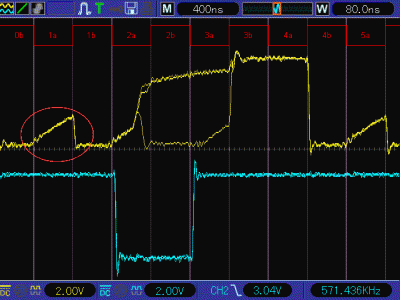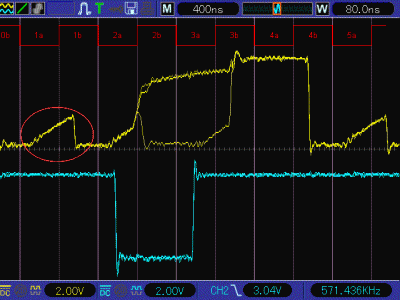OK, so in red I drew the Phase2 waveform in what I suppose to be the the correct relation, and I put the images in a two-frame
animation, ie, with and without the pullup (below). It's no surprise to see that the pullup resistor has a distinct effect when Phase2 is low (for example in the first part of cycle 1, which I circled). This is entirely harmless. The 'C02 will always tri-state the data bus during Phase2 low, and ideally (but depending on its wiring) the host system will do the same. Hence there's nothing to prevent the pullup from pulling up.
The last half of cycle 2 seems strange, though. In the no-pullup frame we see the voltage drop sharply at the end (late in period 2b). Although it's slightly OT, I'm puzzled and bothered by this. It suggests something odd about the device, something odd about your wiring or the way the experiment was done, or something I'm missing or don't understand.
Just checking - you said the blue curve is the TMS9929's /CSR pin. Is that the device's chip-select input? Can you post or link to a datasheet for that chip? And did I get Phase2 in the correct relation to the other waveforms? Edit: alternative Phase2 interpretation added.
-- Jeff
Attachment:
 Animation - effect of pullup resistor v1.gif [ 25.97 KiB | Viewed 1298 times ]
Animation - effect of pullup resistor v1.gif [ 25.97 KiB | Viewed 1298 times ]
Attachment:
 Animation - effect of pullup resistor v2.gif [ 26.29 KiB | Viewed 1298 times ]
Animation - effect of pullup resistor v2.gif [ 26.29 KiB | Viewed 1298 times ]
_________________
In 1988 my 65C02 got six new registers and 44 new full-speed instructions!
https://laughtonelectronics.com/Arcana/ ... mmary.html






